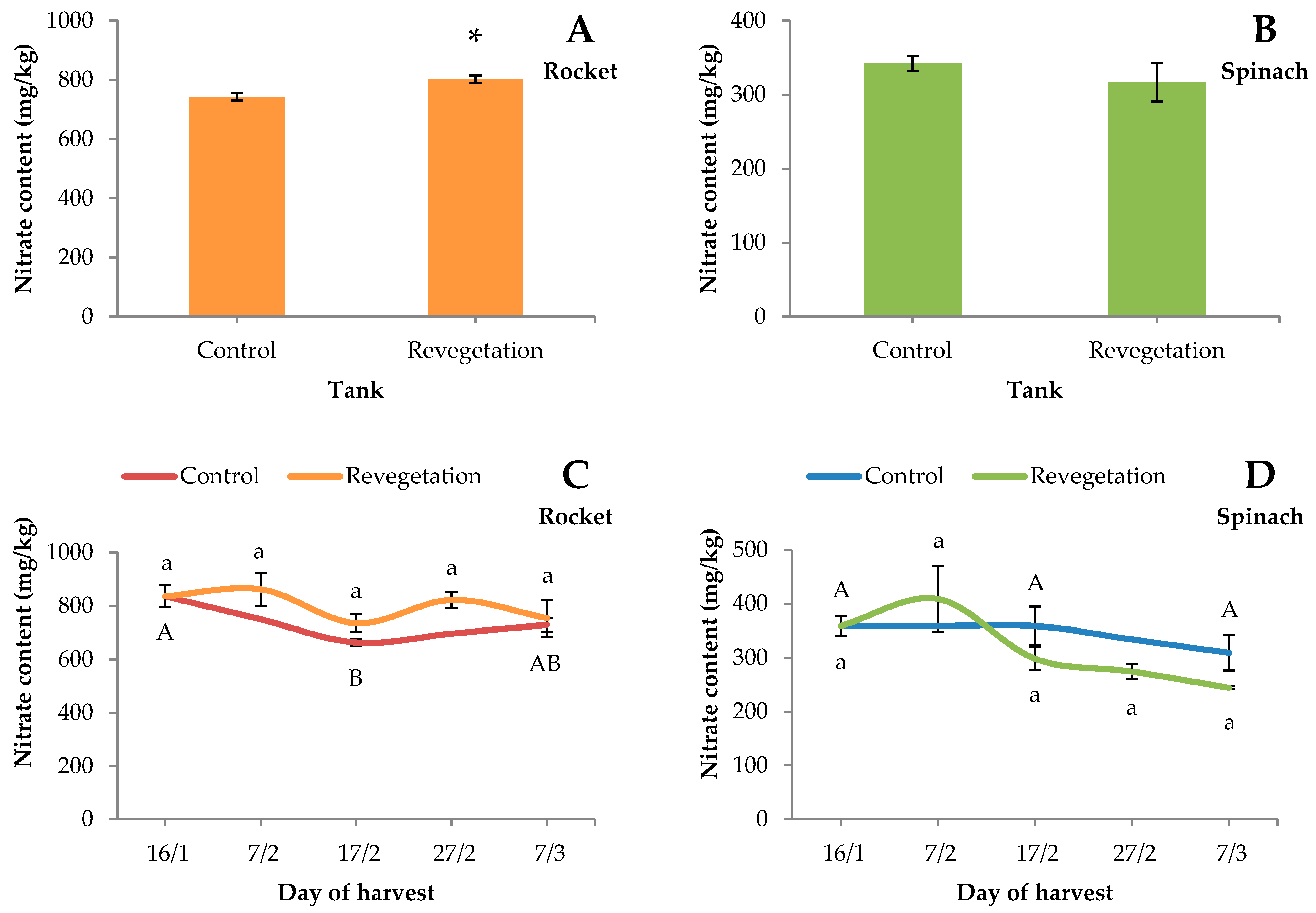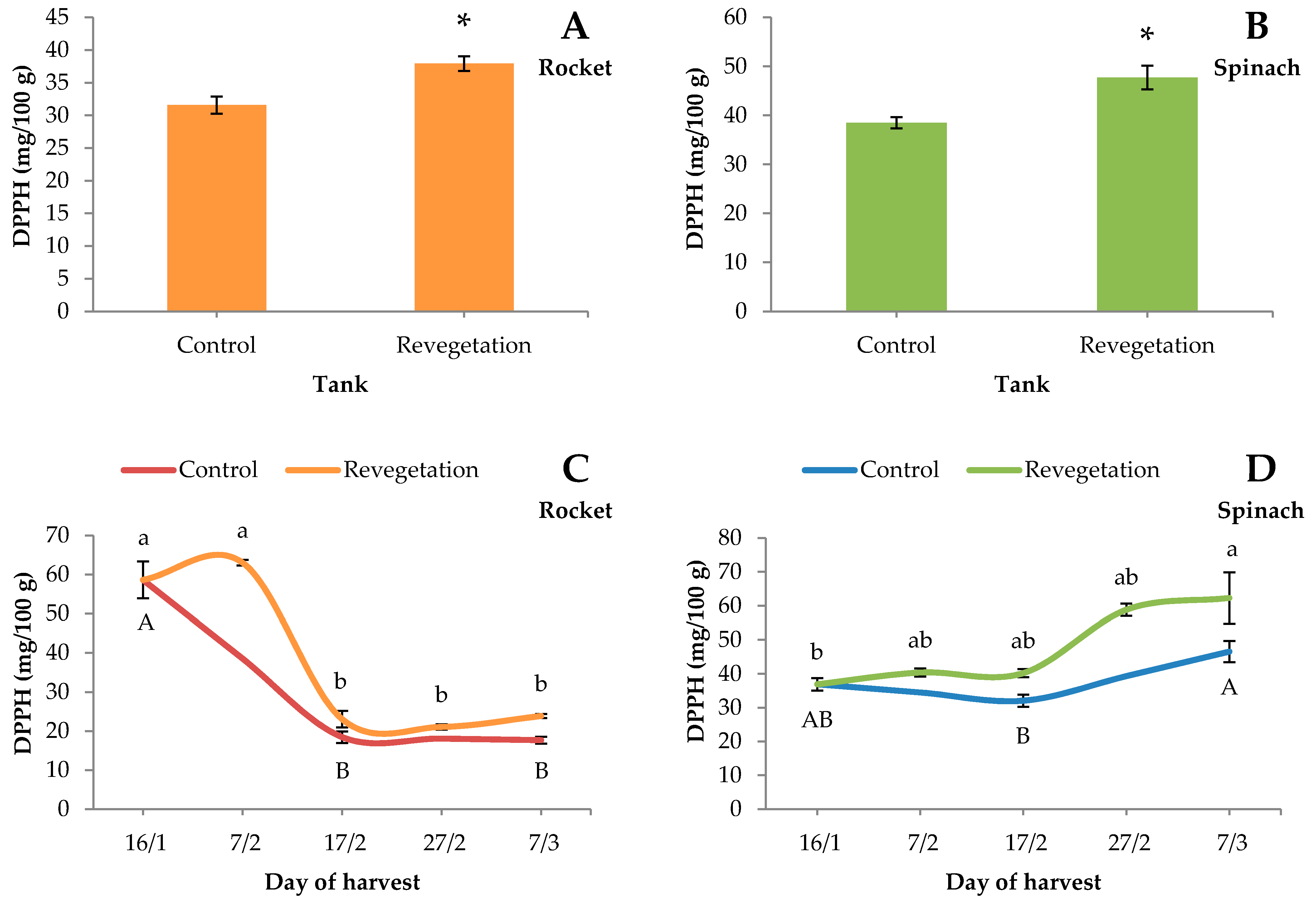Strategic Successive Harvesting of Rocket and Spinach Baby Leaves Enhanced Their Quality and Production Efficiency
Abstract
:1. Introduction
2. Materials and Methods
2.1. Plant Material and Experimental Design
2.2. Experimental Determinations
3. Results and Discussion
4. Conclusions
Author Contributions
Funding
Institutional Review Board Statement
Acknowledgments
Conflicts of Interest
References
- Chisari, M.; Todaro, A.; Barbagallo, R.N.; Spagna, G. Salinity effects on enzymatic browning and antioxidant capacity of fresh-cut baby Romaine lettuce (Lactuca sativa L. cv. Duende). Food Chem. 2010, 119, 1502–1506. [Google Scholar] [CrossRef]
- Koukounaras, A.; Siomos, A.S.; Sfakiotakis, E. Postharvest CO2 and ethylene production and quality of rocket (Eruca sativa Mill.) leaves as affected by leaf age and storage temperature. Postharvest Biol. Technol. 2007, 46, 167–173. [Google Scholar] [CrossRef]
- Proteggente, A.R.; Pannala, A.S.; Paganga, G.; Buren, L.V.; Wagner, E.; Wiseman, S.; Put, F.V.; Dacombe, C.; Rice-Evans, C.A. The antioxidant activity of regularly consumed fruit and vegetables reflects their phenolic and vitamin C composition. Free Radic. Res. 2002, 36, 217–223. [Google Scholar] [CrossRef] [PubMed]
- Roberts, J.L.; Moreau, R. Functional properties of spinach (Spinacia oleracea L.) phytochemicals and bioactives. Food Funct. 2016, 7, 3337–3353. [Google Scholar] [CrossRef]
- Conesa, E.; Niñirola, D.; Vicente, M.J.; Ochoa, J.; Bañón, S.; Fernández, J.A. The influence of nitrate/ammonium ratio on yield quality and nitrate, oxalate and vitamin c content of baby leaf spinach and bladder campion plants grown in a floating system. Acta Hortic. 2009, 843, 269–274. [Google Scholar] [CrossRef]
- Branca, F.; Ragusa, L.; Tribulato, A.; Lo Scalzo, R.; Picchi, V.; Argento, S. The glucosinolates and variation of antioxidant compounds is seeds and sprourts of broccoli (Brassica oleraracea L. var. Italic) and rocket (Eruca sativa L.) in relation to temperature and germination stage. Acta Hortic. 2013, 1005, 271–277. [Google Scholar] [CrossRef]
- Koukounaras, A.; Siomos, A.S.; Sfakiotakis, E. 1-Methylcyclopropene prevents ethylene induced yellowing of rocket leaves. Postharvest Biol. Technol. 2006, 41, 109–111. [Google Scholar] [CrossRef]
- Hambridge, T. Nitrate and Nitrite: Intake Assessment; WHO Food Additives Series 50; WHO: Geneva, Switzerland, 2003. [Google Scholar]
- Santamaria, P. Nitrate in vegetables: Toxicity, content, intake and EC regulation. J. Sci. Food Agric. 2006, 86, 10–17. [Google Scholar] [CrossRef]
- Santamaria, P.; Elia, A.; Serio, F.; Todaro, E. A survey of nitrate and oxalate content in fresh vegetables. J. Sci. Food Agric. 1999, 79, 1882–1888. [Google Scholar] [CrossRef]
- Gimenez, A.; Fernandez, J.A.; Pascual, J.A.; Ros, M.; Saez-Tovar, J.; Martinez-Sabater, E.; Gruda, N.S.; Egea-Gilaber, C. Promising Composts as Growing Media for the Production of Baby Leaf Lettuce in a Floating System. Agronomy 2020, 10, 1540. [Google Scholar] [CrossRef]
- Fallovo, C.; Rouphael, Y.; Rea, E.; Battistelli, A.; Colla, G. Nutrient solution concentration and growing season affect yield and quality of Lactuca sativa L. var. acephala in floating raft culture. J. Sci. Food Agric. 2009, 89, 1682–1689. [Google Scholar] [CrossRef]
- Nicola, S.; Hoeberechts, J.; Fontana, E. Comparison between traditional and soilless culture systems to produce rocket (Eruca sativa) with low nitrate content. Acta Hortic. 2005, 697, 549–555. [Google Scholar] [CrossRef]
- Zanin, G.; Ponchia, G.; Sambo, P. Yield and quality of vegetables grown in a floating system for ready to-eat produce. Acta Hortic. 2009, 807, 433–438. [Google Scholar] [CrossRef]
- Cross, V.; Martinez-Sanchez, J.J.; Franco, J.A. Good yields of common purslane with a high fatty acid content can be obtained in a peat-based floating system. HortTechnology 2007, 17, 14–20. [Google Scholar] [CrossRef] [Green Version]
- Pennisi, G.; Orsini, F.; Landolfo, M.; Pistillo, A.; Crepaldi, A.; Nicola, S.; Fernandez, J.A.; Marcelis, L.F.M.; Giaquinto, G. Optimal photoperiod for indoor cultivation of leafy vegetables and herbs. Eur. J. Hortic. Sci. 2020, 85, 329–338. [Google Scholar] [CrossRef]
- Bantis, F.; Fotelli, M.; Ilic, Z.S.; Koukounaras, A. Physiological and Phytochemical Responses of Spinach Baby Leaves Grown in a PFAL System with LEDs and Saline Nutrient Solution. Agriculture 2020, 10, 574. [Google Scholar] [CrossRef]
- Carillo, P.; Giordano, M.; Raimondi, G.; Napolitano, F.; Di Stasio, E.; Kyriacou, M.C.; Sifola, M.I.; Rouphael, Y. Physiological and Nutraceutical Quality of Green and Red Pigmented Lettuce in Response to NaCl Concentration in Two Successive Harvests. Agronomy 2020, 10, 1358. [Google Scholar] [CrossRef]
- Bianco, V.V.; Boari, F.; Pezzuto, A. Effect of nitrogen and plant density on direct-seeded or transplanted wild rocket. Acta Hortic. 1996, 467, 227–285. [Google Scholar] [CrossRef]
- Hoagland, D.R.; Arnon, D.I. The Water-Culture Method for Growing Plants without Soil, 2nd ed.; Circular—California Agricultural Experiment Station: Berkeley, CA, USA, 1950; p. 347. [Google Scholar]
- Karnoutsos, P.; Karagiovanidis, M.; Bantis, F.; Chatzistathis, T.; Koukounaras, A.; Ntinas, G.K. Controlled root-zone temperature effect on baby leaf vegetables yield and quality in a floating system under mild and extreme weather conditions. J. Sci. Food Agric. 2020. Epub ahead of print. [Google Scholar] [CrossRef]
- McGuire, R.G. Reporting of objective color measurements. HortScience 1992, 27, 1254–1255. [Google Scholar] [CrossRef] [Green Version]
- Cataldo, D.A.; Haroon, M.H.; Schrader, L.E.; Youngs, V.L. Rapid colorimetric determination of nitrate in plant tissue by nitration of salicylic acid. Commun. Soil Sci. Plant Anal. 1975, 6, 71–80. [Google Scholar] [CrossRef]
- Singleton, V.L.; Rossi, J.A. Colorimetry of total phenolics with phosphomolybdic-phosphotungstic acid reagents. Am. J. Enol. Vitic. 1965, 16, 144–158. [Google Scholar]
- Brand-Williams, W.; Cuvelier, M.E.; Berset, C. Use of free radical method to evaluate antioxidant activity. Food Sci. Technol. 1995, 28, 25–30. [Google Scholar] [CrossRef]
- Aoki, M. Consumer loyalty towards locally certified low-input farm products. Br. Food J. 2015, 117, 2300–2312. [Google Scholar] [CrossRef]
- Kristensen, H.L.; Stavridou, E. Deep root growth and nitrogen uptake by rocket (Diplotaxis tenuifolia L.) as affected by nitrogen fertilizer, plant density and leaf harvesting on a coarse sandy soil. Soil Use Manag. 2017, 33, 62–71. [Google Scholar] [CrossRef]
- Ciriello, M.; Formisano, M.; El-Nakhel, C.; Kyriacou, M.C.; Soteriou, G.A.; Pizzolongo, F.; Romano, R.; De Pascale, S.; Rouphael, Y. Genotype and Successive Harvests Interaction Affects Phenolic Acids and Aroma Profile of Genovese Basil for Pesto Sauce Production. Foods 2021, 10, 278. [Google Scholar] [CrossRef]
- Corrado, G.; Chiaiese, P.; Lucini, L.; Miras-Moreno, B.; Colla, G.; Rouphael, Y. Successive Harvests Affect Yield, Quality and Metabolic Profile of Sweet Basil (Ocimum basilicum L.). Agronomy 2020, 10, 830. [Google Scholar] [CrossRef]
- Medina, M.S.; Tudela, J.A.; Marín, A.; Allende, A.; Gil, M.I. Short postharvest storage under low relative humidity improves quality and shelf life of minimally processed baby spinach (Spinacia oleracea L.). Postharvest Biol. Technol. 2012, 67, 1–9. [Google Scholar] [CrossRef]
- Madeira, A.C.; Ferreira, A.; De Varennes, A.; Vieira, M.I. SPAD meter versus tristimulus colorimeter to estimate chlorophyll content and leaf color in sweet pepper. Commun. Soil Sci. Plant Anal. 2003, 34, 2461–2470. [Google Scholar] [CrossRef]
- Bell, L.; Lignou, S.; Wagstaff, C. High Glucosinolate Content in Rocket Leaves (Diplotaxis tenuifolia and Eruca sativa) after Multiple Harvests Is Associated with Increased Bitterness, Pungency, and Reduced Consumer Liking. Foods 2020, 9, 1799. [Google Scholar] [CrossRef]
- Chung, J.-B.; Jin, S.-J.; Cho, H.-J. Low water potential in saline soils enhances nitrate accumulation of lettuce. Coummun. Soil Sci. Plant Anal. 2007, 36, 1773–1785. [Google Scholar] [CrossRef]
- Hord, N.G.; Tang, Y.; Bryan, N.S. Food sources of nitrates and nitrites: The physiologic context for potential health benefits. Am. J. Clin. Nutr. 2009, 90, 1–10. [Google Scholar] [CrossRef] [PubMed]
- Petropoulos, S.; Fernandes, A.; Karkanis, A.; Ntatsi, G.; Barros, L.; Ferreira, I.C.F.R. Successive harvesting affects yield, chemical composition and antioxidant activity of Cichorium spinosum L. Food Chem. 2017, 237, 83–90. [Google Scholar] [CrossRef] [PubMed] [Green Version]
- Lattanzio, V.; Lattanzio, V.M.T.; Cardinali, A. Role of phenolics in the resistance mechanisms of plants against fungal pathogens and insects. In Phytochemistry: Advances in Research; Imperato, F., Ed.; Research Signpost: Trivandrum, India, 2006; pp. 23–67. [Google Scholar]
- Ostan, R.; Lanzarini, C.; Pini, E.; Scurti, M.; Vianello, D.; Bertarelli, C.; Fabbri, C.; Izzi, M.; Palmas, G.; Biondi, F.; et al. Inflammaging and cancer: A challenge for the Mediterranean diet. Nutrients 2015, 7, 2589–2621. [Google Scholar] [CrossRef] [Green Version]




| Tank | Date of Harvest | ||||
|---|---|---|---|---|---|
| 16/1 | 7/2 | 17/2 | 27/2 | 7/3 | |
| Control | |||||
| Harvest | First | - | First | - | First |
| Growth cycle | 34 (46) days | - | 32 (43) days | - | 18 (28 days) |
| Revegetation | |||||
| Harvest | First | Second | Third | Fourth | Fifth |
| Growth cycle | 34 (46) days | 22 days | 10 days | 10 days | 8 days |
| Lightness | Chroma | Hue Angle | SSC | |
|---|---|---|---|---|
| Rocket | ||||
| Control | 44.78 ± 0.49 | 37.86 ± 0.66 | 122.76 ± 0.28 | 3.93 ± 0.10 |
| Revegetation | 45.43 ± 0.47 | 37.51 ± 0.71 | 122.99 ± 0.33 | 4.12 ± 0.03 |
| Spinach | ||||
| Control | 38.94 ± 0.21 | 20.98 ± 0.51 | 125.12 ± 0.11 | 5.86 ± 0.12 |
| Revegetation | 37.84 ± 0.36 | 19.74 ± 0.23 | 125.08 ± 0.08 | 6.53 ± 0.34 |
Publisher’s Note: MDPI stays neutral with regard to jurisdictional claims in published maps and institutional affiliations. |
© 2021 by the authors. Licensee MDPI, Basel, Switzerland. This article is an open access article distributed under the terms and conditions of the Creative Commons Attribution (CC BY) license (https://creativecommons.org/licenses/by/4.0/).
Share and Cite
Bantis, F.; Kaponas, C.; Charalambous, C.; Koukounaras, A. Strategic Successive Harvesting of Rocket and Spinach Baby Leaves Enhanced Their Quality and Production Efficiency. Agriculture 2021, 11, 465. https://doi.org/10.3390/agriculture11050465
Bantis F, Kaponas C, Charalambous C, Koukounaras A. Strategic Successive Harvesting of Rocket and Spinach Baby Leaves Enhanced Their Quality and Production Efficiency. Agriculture. 2021; 11(5):465. https://doi.org/10.3390/agriculture11050465
Chicago/Turabian StyleBantis, Filippos, Chrysos Kaponas, Charalambos Charalambous, and Athanasios Koukounaras. 2021. "Strategic Successive Harvesting of Rocket and Spinach Baby Leaves Enhanced Their Quality and Production Efficiency" Agriculture 11, no. 5: 465. https://doi.org/10.3390/agriculture11050465
APA StyleBantis, F., Kaponas, C., Charalambous, C., & Koukounaras, A. (2021). Strategic Successive Harvesting of Rocket and Spinach Baby Leaves Enhanced Their Quality and Production Efficiency. Agriculture, 11(5), 465. https://doi.org/10.3390/agriculture11050465








